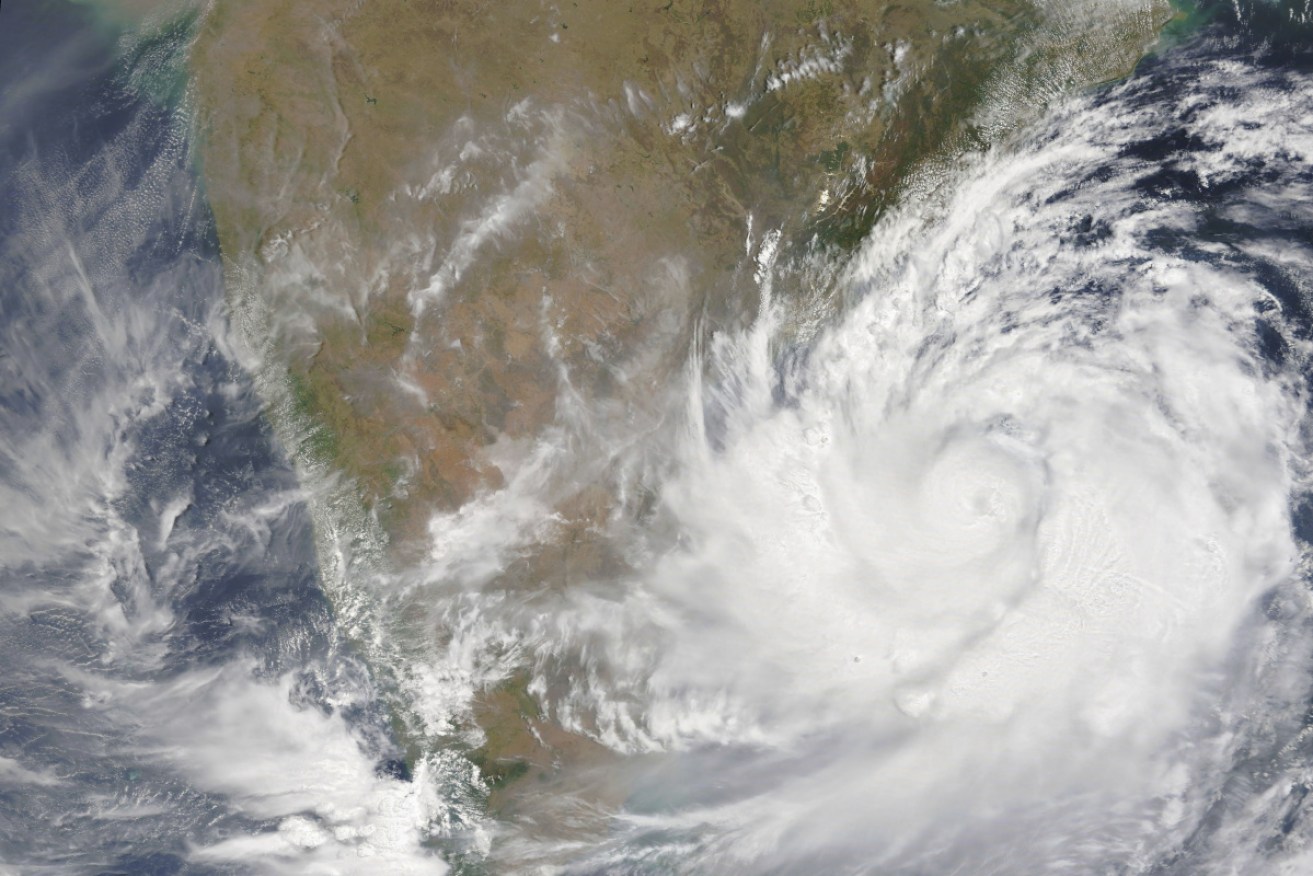Destructive Cyclone Fani makes landfall in eastern India as more than a million people evacuated


NASA's satellite view of Cyclone Fani shows the devastating cyclone moving through the Bay of Bengal. Photo: AAP
The strongest tropical cyclone to churn towards India’s east coast in two decades has made landfall.
Local media reported Cyclone Fani made landfall on Friday as heavy rain and destructive powerful winds lashed dozens of coastal cities and towns.
And overall clip of powerful destructive winds hitting Odisha India, from #CycloneFani. pic.twitter.com/hiRy66iSuH
— Nicholas Barretto (@StormBarretto) May 3, 2019
Authorities issued the country’s largest ever evacuation operation overnight, with almost 900 shelters set up to accommodate the more than one million people who have already been removed from their homes and taken to safety.
All shops, businesses, private and government offices in 11 coastal districts have been forced to shut down.
Power supply has been cut off in hundreds of villages of Vizianagaram and Srikakulam districts, with affected villages receiving up to 18 centimetres of rainfall.
Cyclone Fani has been dubbed the most severe cyclonic storm since a super cyclone with a wind speed of 482km/h struck Odisha on the east coast of India in 1999, killing more than 10,000 people, according to the Joint Typhoon Warning Centre.

Locals take shelter in temporary cyclone relief shelters in Puri in the eastern Indian state of Odisha. Photo: Getty
As Fani barrels towards Odisha’s coast, packing winds gusts of up to 210km/h and torrential rain, authorities have warned that the extremely powerful cyclone is hours away from making landfall.
The Times of India reported an astonishing 10,000 villages and 52 towns are in the path of the cyclone, with road, rail and air traffic completely suspended until the cyclone passes.
By Thursday night (local time), Fani had sustained wind speeds of about 250km/h, equivalent in strength to a Category 4 hurricane, researcher Derrick Herndon said.
Have a look at the system. Video courtesy https://t.co/oRhiwPLN3U pic.twitter.com/zAhvolrEF2
— SpokespersonNavy (@indiannavy) May 2, 2019
“It’s remarkable in terms of its wind speed,” Mr Herndon said. “The sustained winds are really near the top range of the winds we see in this part of the world.”
Tropical cyclone-force winds are already coming ashore in portions of Andhra Pradesh in the country’s north-west.
The Indian Coast Guard has deployed as many as 48 disaster relief teams and stocked up medicines and food supplies in preparation.
Seven warships and seven helicopters are on standby at several Naval Air Stations at Visakhapatnam on the east coast.
Have a look at the roll being experienced by one of the ships deployed in the wake of #CycloneFani. Do notice the totally wet quarter deck..
.. Yes, its getting in and out of water view choppy seas around pic.twitter.com/RqZoDcBPDX— SpokespersonNavy (@indiannavy) May 2, 2019
The India Meteorological Department warned of “extremely heavy falls” over parts of the state of Odisha and its southern neighbour Andhra Pradesh.
Head of the department Mritunjay Mohapatra warned residents not to become complacent as wind speeds drop to a low of 50 km/h in the eye of the cyclone.
“There is a tendency to be complacent after the first arm of the cyclone moves ahead. The first arm brings destruction. The eye, which covers an area of 30-40 kilometres, is usually calm. But as the eye moves forward it is replaced by the second arm of the cyclone which is equally destructive,” Mr Mohapatra said.
Puri: Fishermen in Penthakata village leave their houses for relief centers as #CycloneFani is expected to make a landfall here later today; #visuals from May 2. #Odisha pic.twitter.com/dJfC8jxb72
— ANI (@ANI) May 2, 2019
India’s National Disaster Management Authority forecast “high to phenomenal” sea conditions for most of the Indian states along the Bay of Bengal. Fishermen were advised not to venture into deep waters. A 1.5-metre storm surge was expected to inundate low-lying areas.
On Thursday, Prime Minister Narendra Modi met with cabinet ministers and weather and disaster-response officials for a briefing on the measures being taken.
The Meteorological Department projected “total destruction” of thatched-roof huts, flooding of farmland and orchards, and the uprooting of telephone poles.
Odisha: #Visuals from a relief camp in Puri; Jayanti, a Red Cross member, says, "1,000 people have been evacuated. Many people aren't willing to come, scared their belongings will be stolen. But we'll evacuate them tomorrow morning at any cost.We want zero casualty." #FaniCyclone pic.twitter.com/2zYggJUicm
— ANI (@ANI) May 2, 2019
Tourists were asked to leave the popular beach town of Puri in Odisha by Thursday night.
Fani was also forecast to hit Bangladesh, tracking north through ports including Cox’s Bazar, the coastal district where more than a million Rohingya refugees live in refugee camps.
-with agencies








